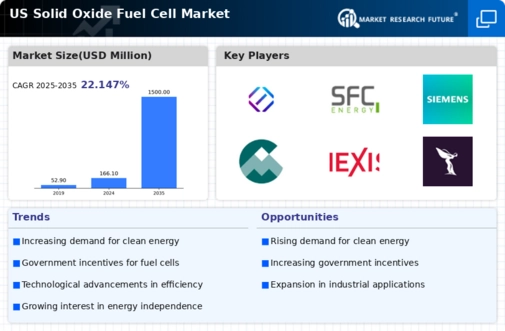Growing Industrial Applications
The solid oxide-fuel-cell market is benefiting from a growing array of industrial applications. Industries such as manufacturing, transportation, and data centers are increasingly adopting fuel cell technology to meet their energy needs. For example, the transportation sector is exploring the use of solid oxide fuel cells in heavy-duty vehicles, which could potentially reduce reliance on diesel engines. Additionally, the market for stationary power generation is expanding, with solid oxide fuel cells being utilized for backup power and grid support. This diversification of applications is expected to drive market growth, with projections indicating a potential market size of $1.5 billion by 2030. The solid oxide-fuel-cell market is thus becoming integral to various sectors, enhancing its relevance in the energy landscape.
Increased Focus on Energy Security
Energy security has become a paramount concern for the U.S., driving interest in the solid oxide-fuel-cell market. As geopolitical tensions and supply chain vulnerabilities persist, there is a growing recognition of the need for reliable and resilient energy sources. Solid oxide fuel cells offer a decentralized energy solution, which can enhance energy independence and security. The ability to generate power on-site reduces reliance on external energy supplies, making it an attractive option for both commercial and residential applications. This trend is likely to be supported by federal initiatives aimed at bolstering domestic energy production, further propelling the solid oxide-fuel-cell market. The potential for solid oxide fuel cells to contribute to a more secure energy future is becoming increasingly evident.
Investment in Infrastructure Development
Investment in infrastructure development is a critical driver for the solid oxide-fuel-cell market. As the U.S. transitions towards cleaner energy systems, there is a pressing need for modernized energy infrastructure. Solid oxide fuel cells can be integrated into existing energy systems, providing a flexible and efficient solution for power generation. The Biden administration's infrastructure plan includes provisions for clean energy technologies, which could facilitate the deployment of solid oxide fuel cells across various sectors. With an estimated $1 trillion earmarked for infrastructure improvements, the solid oxide-fuel-cell market stands to benefit significantly from this investment. This focus on infrastructure not only supports the growth of the market but also aligns with broader goals of sustainability and energy efficiency.
Rising Demand for Clean Energy Solutions
The solid oxide-fuel-cell market is experiencing a notable surge in demand driven by the increasing emphasis on clean energy solutions. As environmental concerns escalate, industries and consumers alike are seeking alternatives to fossil fuels. The U.S. government has set ambitious targets to reduce greenhouse gas emissions by 50-52% by 2030, which is likely to bolster the adoption of solid oxide fuel cells. This technology offers high efficiency and low emissions, making it an attractive option for power generation. Furthermore, the market is projected to grow at a CAGR of approximately 15% over the next five years, indicating a robust shift towards sustainable energy sources. The solid oxide-fuel-cell market is thus positioned to play a crucial role in meeting these energy demands while contributing to environmental sustainability.
Technological Innovations Enhancing Efficiency
Technological advancements in the solid oxide-fuel-cell market are significantly enhancing the efficiency and performance of fuel cells. Innovations such as improved materials and manufacturing processes are leading to higher power densities and lower operating temperatures. For instance, the development of advanced ceramic materials has been shown to increase the durability and efficiency of solid oxide fuel cells. As a result, the operational costs are expected to decrease, making this technology more competitive against traditional energy sources. The market is witnessing investments in R&D, with funding reaching approximately $200 million in 2025, aimed at further enhancing the capabilities of solid oxide fuel cells. This trend indicates a strong commitment to advancing the technology, which is likely to attract more stakeholders to the solid oxide-fuel-cell market.






















Leave a Comment